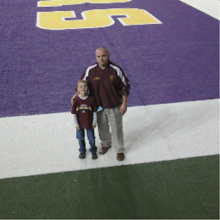What does 1:1 Mean to You?
Recently, we began discussing (in our district) the possibility of going to a 1:1 program. The discussion has evolved from conversations, tech sessions, and our observations of what other schools are doing. For the past several years, I have watched as a neighboring district implemented a 1:1 program for their 4th grade students via MLDs (aka Mobile Learning Devices) and soon after, our district did the same. Both districts have expanded their program and now, we are considering how the evolution of this technology will impact our current 5th graders (who all have a device) if we don't change how we operate in the high school classroom.
So this is where we are... how do we prepare to teach a different type of student? The 'Networked Student' (see video below)? We have been saying for years that students' needs are different today than they were 5 or 10 years ago. So how do (or should) we as educators adjust and change to meet the needs of these 21st Century students?
Going 1:1 (putting a device in the hands of all students) is not the solution. This new tool can certainly be used in the process, almost as a vehicle for getting us to a 21st Century classroom. But it is in no means the end-all, be-all. 21st Century classrooms must teach students how to collaborate, how to innovate, how to communicate (digitally and otherwise), how to investigate, how to research, how to use every tool at their disposal in order to problem solve.
In a discussion with a group of teachers recently, the issue came up as to whether or not we were degrading the basic skills by using too much technology. Making students memorize facts that they can Google isn't educating them. Teaching students how to find information and then evaluate, synthesize, and analyze that information in order to solve a problem or create a solution is educating them.
In a recent conversation with my good friend and teacher @SNewco, we were discussing a math problem he had given his students. He had expected them to have to use paper and pencil to come up with the answer. One student, however, used Google and some other intuitive internet research on his MLD to arrive at the correct answer. While stunned,@SNewco couldn't have been happier with his student's ability to find the correct answer. This is 21st Century Learning! We have to change how we question and teach our students, knowing full well that they have the ability to 'Google' the answer!
To me, going 1:1 next school year is no different than it probably was to give every student a book 100 years ago. Sure its the next big thing, but it is becoming a standard item. I would be willing to predict that within 5 years, the word 1:1 will be nearly obsolete. A learning device (i.e. smart phone, iPad, netbook, ipod, etc.) will be the standard, not the anomaly. In reality, long before my career is over, a student device with be as standard as a 3-ring binder or a calculator is today.
So the question isn't should we or shouldn't we go 1:1... the real question iswill we be ready when the students are?
So this is where we are... how do we prepare to teach a different type of student? The 'Networked Student' (see video below)? We have been saying for years that students' needs are different today than they were 5 or 10 years ago. So how do (or should) we as educators adjust and change to meet the needs of these 21st Century students?
Going 1:1 (putting a device in the hands of all students) is not the solution. This new tool can certainly be used in the process, almost as a vehicle for getting us to a 21st Century classroom. But it is in no means the end-all, be-all. 21st Century classrooms must teach students how to collaborate, how to innovate, how to communicate (digitally and otherwise), how to investigate, how to research, how to use every tool at their disposal in order to problem solve.
In a discussion with a group of teachers recently, the issue came up as to whether or not we were degrading the basic skills by using too much technology. Making students memorize facts that they can Google isn't educating them. Teaching students how to find information and then evaluate, synthesize, and analyze that information in order to solve a problem or create a solution is educating them.
In a recent conversation with my good friend and teacher @SNewco, we were discussing a math problem he had given his students. He had expected them to have to use paper and pencil to come up with the answer. One student, however, used Google and some other intuitive internet research on his MLD to arrive at the correct answer. While stunned,@SNewco couldn't have been happier with his student's ability to find the correct answer. This is 21st Century Learning! We have to change how we question and teach our students, knowing full well that they have the ability to 'Google' the answer!
To me, going 1:1 next school year is no different than it probably was to give every student a book 100 years ago. Sure its the next big thing, but it is becoming a standard item. I would be willing to predict that within 5 years, the word 1:1 will be nearly obsolete. A learning device (i.e. smart phone, iPad, netbook, ipod, etc.) will be the standard, not the anomaly. In reality, long before my career is over, a student device with be as standard as a 3-ring binder or a calculator is today.
So the question isn't should we or shouldn't we go 1:1... the real question iswill we be ready when the students are?
